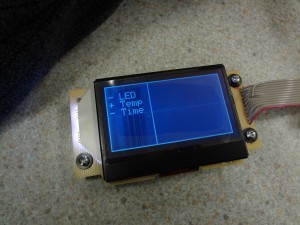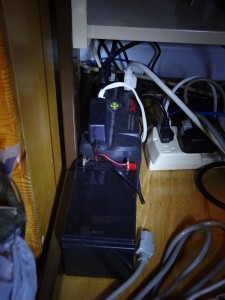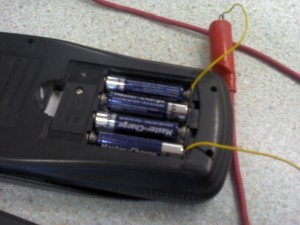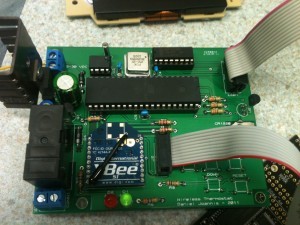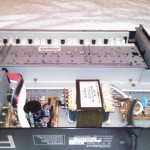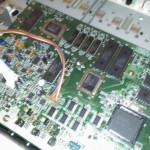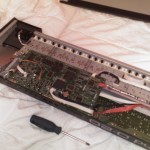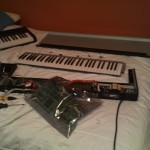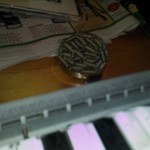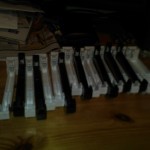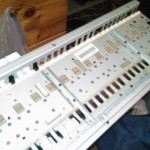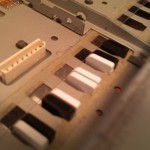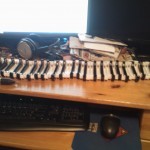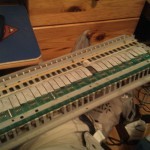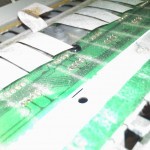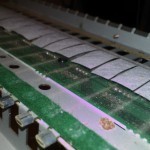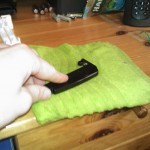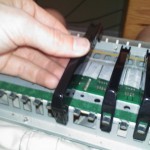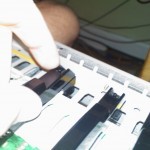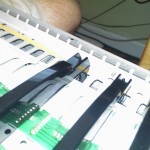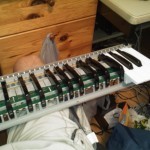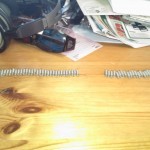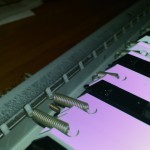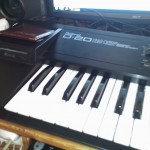projects
Uninterruptible Power Supply
Being a very technology-inclined person, electricity has an important role in much of my daily life. Many of my tools require it (I include computers in this category) and, when the power goes out, it is the absence of server noise that alerts me, not that of light. The best way to keep these devices running is with a UPS (see previous post on the subject).
Network
Above is the “defender of the Internet” – this UPS keeps the modem, router, gigabit switch (and in passing, my amplifier) powered in the event of a power outage.
This UPS was $15 at a thrift store, is rated for 350VA (so… 275W?), and originally came with a 7Ah battery. Naturally, the battery was toast. I instead ran some wire from the terminals to a 12Ah battery from a broken car booster pack. Yes, I simply wrapped the wire around the terminal.
I haven’t tested the life span, however I once left it unplugged, with my amplifier playing music, for 30 minutes without failure. Boredom led me to plug it back in. I expect it should last several hours powering only the network.
Server
The server has 8 hard drives, and consumes a fair amount of electricity (more than the small UPS can provide). Because of this, a much larger UPS is needed. While browsing Kijiji one day, it occurred to me that I’ve never checked there for a UPS before. It was a good thing I did this time:
Charging Non-Rechargeable Alkaline Batteries
I’ve always been a fan of rechargeable batteries because batteries, as a one-time-use product, simply don’t make sense. The ability to recharge the same batteries, hundreds of times, means less waste and more value for money. A downside to NiMH and NiCad batteries is that they output a lower voltage: 1.2V instead of the 1.5V provided by alkaline batteries, which can result in some devices displaying incorrect battery levels or shutting down too soon.
Another major downside is price, and shady marketing. Several years ago a 4 pack of rechargeable NiMH AAs, at 2500mAh, would cost about $12. It was a premium over alkaline batteries, but it was great value considering the many additional uses. However, these days I can’t seem to find the same type and capacity of batteries for under $17 at retail stores. Those batteries that are under $17 often do not have their capacity marked anywhere on the packaging or themselves. After some research, I discovered that these [brand withheld] batteries are only 1200mAh – less than half the standard for NiMH AAs.
It is unfortunate that a product that was once so economical and convenient was turned into nothing more than a cash grab. “Save the environment” slogans leading consumers to buy products at marked up prices. Supply and demand fails in this system. But I digress.
At the beginning of the semester, I turned on my calculator to find the “low battery” nag screen, followed by an immediate shut down. They were depleted. Being curious, and a little cheap, I decided to act upon an article I had read years ago. The article describes how, with patience and constant attention (if you wish to avoid acid explosions), you can recharge “non-rechargeable” alkaline batteries.
Video Blog – Laser Projectors
We upgraded the arcade again, this time adding some awesome, hypnotizing laser projectors! One displays a constant pattern, the other is reactive to music. We also installed a motorized disco ball, which reflects the lasers around the room!
Build Journal – Final Project – Schematic
Over the next little while I will bring you through the processes of engineering my final project. From circuit design, prototyping, PCB layout, hardware manufacture, programming, and final packaging, I will give you a commentary on my choices, and what I might have done differently. Hopefully you can learn something in the process!
Before we get too far ahead in the project, let’s start at the beginning.
Photo Blog – Cleaning out my Roland D-20
My uncle was kind enough to lend me his faithful but underused Roland D-20. For the last 4 years. The less feature-packed sibling of the D-50, the D-20 is still a very powerful keyboard. It is a “multi timbral linear synthesizer multi track sequencer”, according to the imprint on it’s face. I have used this keyboard in the studio and on stage, and despite being manufactured in 1988, it still sounds and performs as new.
Alas, it has not been used intensely for a long time, and dust had begun to accumulate. Today I felt the D-20 belonged on my desk, and once I’d moved it from the stand, I began to clean the keys. However, a bit of water trickled down in between the keys, and I was not going to turn it on for risk of there still being water down there. So I took it apart, and began a 3 hour journey to clean the D-20, from the inside out.
YouTube Series – Android on the Xperia X1
Although I’ve retired it from active cellphone duty, my Xperia X1 still has something about it that makes it special. The screen has great pixel density, the slide-out keyboard is easy to use, and it feels solid and heavy.
The only real downside to this phone is the OS (and, perhaps it is a bit dated with only 256MB of RAM). Windows Mobile 6 was acceptable years ago, but with options like Android around, it just doesn’t cut it. However, there is a large group of people over at the XDA Forums who work to bring out new, different builds of Android for the X1, allowing you to dual-boot Windows Mobile and Android! I’ve played around with quite a few, and I figured I could make a video series with me trying out different builds.
Without further ado, here is the first video of the series – Installing Android.
When a Project Isn’t Successful
For every project I post on here where I obtain the results I was looking for, chances are there are two other projects I’ve tried that didn’t quite work out. Such is the nature of tinkering and hacking for fun.
Just because it ended in failure (and occasionally, catastrophic failure), it doesn’t mean I’ve wasted my time – here are some lessons I’ve learnt from failure over time.
How To: Fix 1997 Honda Accord DRL Relay
A common problem with the Daytime Running Light (DRL) module in many 90’s Honda vehicles is cold solder joints at the relays in the control module. These develop over time, and cause sometimes intermittent issues with running lights. I encountered this problem, which would usually present itself on mornings with lots of dew, and would fix itself sometime during my commute to work. Rather than pay a mechanic to repair or replace the module, you can do it yourself with some basic tools.
A Google search will reveal many forums and sites with instructions to fix this problem: here are the two links which I consulted prior to performing these repairs.
http://www.nyx.net/~smanley/hondadrlfix/index.html
http://www.hondaaccordforum.com/forum/general-tech-help-7/drl-fix-3719/
Ottawa Pinball Expo – 2011 (Video)
Here is my video of the first ever Ottawa Pinball Expo! We brought three machines to the show, and I am pleased to say I played every free-play machine there! It was great fun, and I can’t wait for next year!
Filmed, edited and soundtrack composed by myself.
